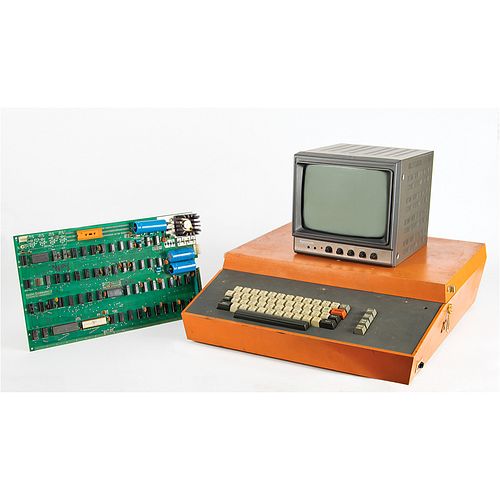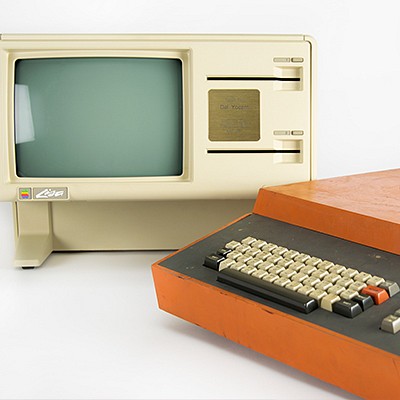Apple-1 Computer Signed by Steve Wozniak
Two ways to bid:
- Leave a max absentee bid and the platform will bid on your behalf up to your maximum bid during the live auction.
- Bid live during the auction and your bids will be submitted real-time to the auctioneer.
Bid Increments
| Price | Bid Increment |
|---|---|
| $0 | $5 |
| $50 | $10 |
| $200 | $25 |
| $500 | $50 |
About Auction
Mar 16, 2023
RR Auction support@rrauction.com
- Lot Description
Highly sought-after fully functional 'Byte Shop'-style Apple-1 computer (also commonly known as the Apple I, or Apple Computer 1), complete with all components and accessories required for operation. This computer was originally used as a demonstration system at the Data Domain computer store in Columbus, Indiana, in 1977, before being given to the current owner in 1978. It is an extreme rarity as a signed, serial-numbered, operational, one-owner and 'undiscovered' Apple-1, not logged in the Apple-1 Registry, never offered for sale, nor known to the Apple-1 collector community.
The set includes:
• original Apple-1 board, signed in black enamel paint marker by Steve Wozniak, and marked with “01-0064” on the back
• original Apple Cassette Interface (ACI) board
• original period case from the 'Data Domain' store, with original power supply and original rare Clare-Pendar ASCII keyboard
• unbound copies of the 2nd versions of the Apple-1 Operation Manual and Preliminary Apple Basic User's Manual
• bound original Apple Cassette Interface Manual
• period-correct Panasonic RQ3109DS portable cassette tape recorder
• compatible Panasonic TR-930U CRT monitor
• iPod Touch (7th Generation) and associated cables, containing Apple-1 software audio files and videos showing Steve Wozniak signing this Apple-1 and former Apple employee Daniel Kottke performing the original restoration
This Apple-1 computer was initially brought to an operational state by Daniel Kottke, Apple Computer employee #12, in 2019. Apple-1 expert Corey Cohen performed additional restoration of the Apple-1 board and the ACI in November 2022 to correct a known reliability issue with the original cassette interface design. A comprehensive, technical condition report and proof-of-life video prepared by Cohen is available to qualified bidders. Videos of Woz signing the board, Kottke performing the initial restoration, and the computer successfully operating are available.
Also accompanied by a lengthy, detailed provenance statement from the consignor, whose early exposure to computing with this Apple-1 laid the foundation for a career in software development and hardware research and design.
The Apple-1 was originally conceived by Steve Jobs and Steve ‘Woz’ Wozniak as a bare circuit board to be sold as a kit and completed by electronics hobbyists, their initial market being Palo Alto’s Homebrew Computer Club. Seeking a larger audience, Jobs approached Paul Terrell, owner of The Byte Shop in Mountain View, California, one of the first personal computer stores in the world. Aiming to elevate the computer beyond the realm of the hobbyist, Terrell agreed to purchase 50 Apple-1 computers, but only if they were fully assembled. The Apple-1 thus became one of the first ‘personal’ computers which did not require soldering by the end user.
In the summer of 1976, Data Domain, a pioneering computer shop—believed to have been the first retailer to use the phrase 'personal computer'—also became one of Apple's first four dealers. The firm's founder, Ray Borrill, recalled his first conversation with Steve Jobs: 'He went into his spiel about what a great computer he had since there was no assembly required (a slight exaggeration since one had to wire a power supply, keyboard cable, display monitor and some other ancillary stuff, then find a way to package it all up nicely). But Jobs was a good talker and we needed some more products to sell. So, as was routine in those early days, I ordered 15 Apple I computers with the optional cassette interface card, sight unseen, on the word of a guy I had never met or heard of.' All together, over a span of about ten months, Jobs and Wozniak produced about 200 Apple-1 computers and sold 175 of them.
Based on installed components, this Apple-1 appears to be a later pre-NTI board from between the initial Byte Shop delivery and the move to NTI-produced PC boards. This Apple-1 has the original rare white Synertek C6502 microprocessor in good condition with very minor corrosion on the top cap. On the left side, the board is marked: “Apple Computer 1, Palo Alto, Ca. Copyright 1976.” The reverse is marked in black felt tip, "01-0064." There is a single minor repair by Dan Kottke on the reverse side to patch a cut trace. A few minor modifications have been made to the prototyping area of the board, including the addition of an orange socket, some minor soldering re-work on the front side, as well as a few missing and lifted solder pads in the prototyping area only. Finally, there is minimal peeling of the green solder-mask coat on the reverse side, due to normal heat from power-supply components.
Presented in its period case, as used at one of the pioneering computer retailers that helped to bring about the personal computer revolution, this is an exceptional and historic example of an Apple-1 Computer. - Shipping Info
-
Bidder is liable for shipping and handling and providing accurate information as to shipping or delivery locations and arranging for such. RR Auction is unable to combine purchases from other auctions or affiliates into one package for shipping purposes. Lots won will be shipped in a commercially reasonable time after payment in good funds for the merchandise and the shipping fees are received or credit extended, except when third-party shipment occurs. Bidder agrees that service and handling charges related to shipping items which are not pre-paid may be charged to a credit card on file with RR Auction. Successful international Bidders shall provide written shipping instructions, including specified Customs declarations, to RR Auction for any lots to be delivered outside of the United States. NOTE: Declaration value shall be the item’(s) hammer price and RR Auction shall use the correct harmonized code for the lot. Domestic Bidders on lots designated for third-party shipment must designate the common carrier, accept risk of loss, and prepay shipping costs.
-
- Buyer's Premium



 EUR
EUR CAD
CAD AUD
AUD GBP
GBP MXN
MXN HKD
HKD CNY
CNY MYR
MYR SEK
SEK SGD
SGD CHF
CHF THB
THB

























